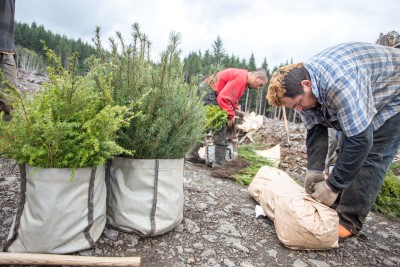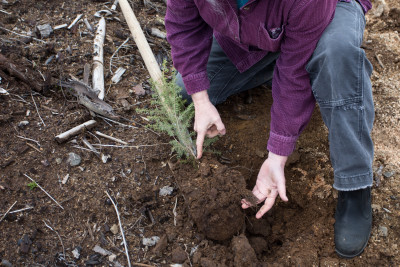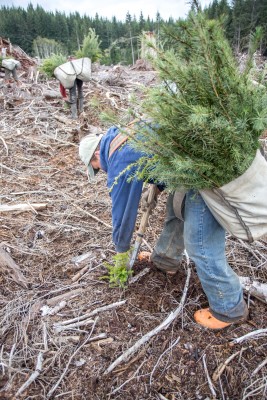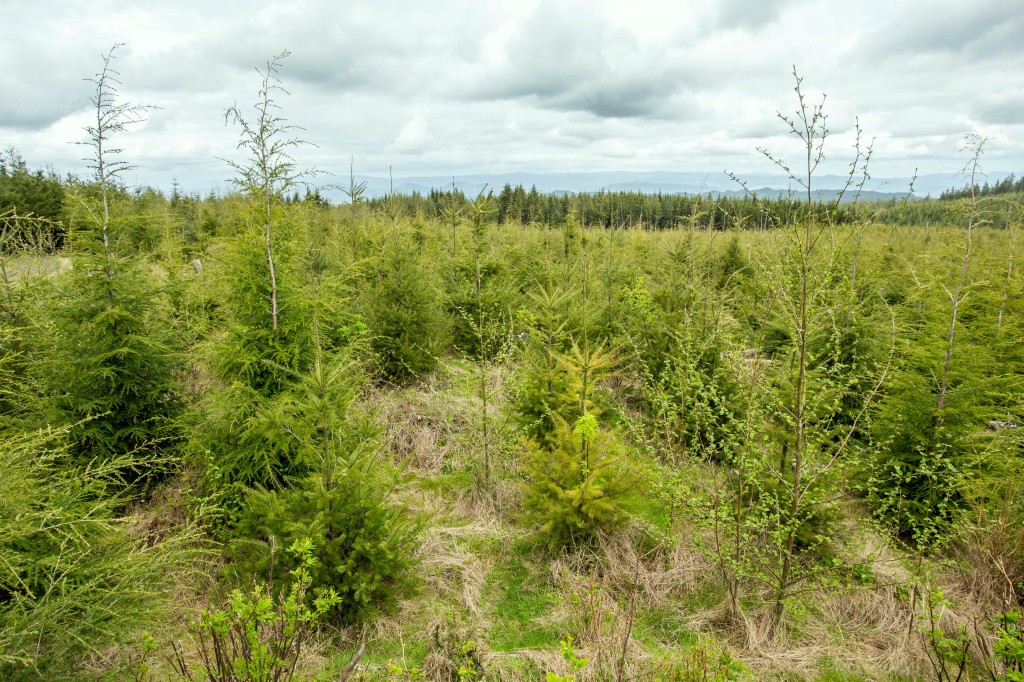On the last Friday of April, people all around the country take a moment to recognize the importance of planting trees. While this official Arbor Day only comes around once a year, Oregon foresters recognize the importance of planting trees every day. More than 40 million tree seedlings are planted in Oregon’s forests each year to reforest areas that have been harvested, burned by wildfire, or are otherwise understocked, thereby renewing a sustainable source of locally grown timber and ensuring that each acre of forest land is productively growing beautiful, healthy, Oregon trees.
Reforestation is serious business, not only because Oregon’s strict forest practices laws require it, but also because ensuring those seedlings get a good start sets the stage in that young forest for the next 45 to 60 years. For forest landowners, it’s one of very few opportunities to help steer how this land performs for decades to come.

Tree planting crews unpack Douglas-fir and Hemlock tree seedlings and load them into carrying bags on Hampton’s Big Creek Tree Farm.
Tree planting in Oregon typically gets underway around February when trees are still in winter dormancy and the hard freezes are over, but the process actually starts two years before that when the seeds started growing in the nursery. Foresters plant tree seedlings (or two-year-old baby trees) even though they cost almost ten times as much as the seeds. Starting the seeds in a nursery dramatically increases the likelihood that the seedlings will survive and reestablish the forest, so it’s worth the extra cost. Douglas-fir seedlings presently cost about 36 to 38 cents each, or about $380 for 1,000. Hemlock, Western Red Cedar, Grand Fir and Noble Fir costs more, at about $420 for 1,000. Foresters make individual decisions based on many factors (elevation, health, soil condition, etc.) about which species and how many trees to plant in a given area, but at roughly 400 trees per acre, landowners are paying about $150 per acre for seedlings alone. The average area being reforested in Oregon is about 50 acres, thus bringing the cost of seedlings for each unit to about $7,500. That number increases substantially as labor, transportation and storage costs are factored in.
Because those seedlings are so precious, considerable care is taken when transporting them from the nursery to the ground. Seedlings are transported in specially lined paper bags or boxes of about 120 in a covered, well ventilated vehicle, and they aren’t stacked too high. In order to prevent damage from drying out, it’s important that the seedlings stay out of direct sunlight and remain in a cool environment. Foresters are careful not to open the bags until right before planting to keep the seedlings in the best possible condition while they’re out of the ground.

Forest manager Beth Fitch verifies proper planting technique, looking for straight roots and correct depth.
When the time comes to put the seedlings in the ground, forest managers hire crews of tree planters who have been trained in the proper technique. It’s not as easy as just sticking the tree in the soil and hoping for the best – the roots need to be straight, the depth and spacing needs to be just right, and the seedlings need to be planted in soil that will provide the nutrients they need, not the remnants of a decomposing stump or other plant material (called duff.) To ensure the seedlings are planted properly, forest managers routinely walk behind the crew and double check their work by counting the number of planted trees in a measured radius and digging up trees to look for proper planting.

Tree planting crews work quickly, alternating between planting Douglas-fir and Hemlock seedlings at Hampton’s Big Creek Tree Farm.
The crew is paid by the number of trees they plant (with mechanisms in place to guarantee quality), which is about 1,200 trees per worker per day. At about ten workers per crew, the team plants roughly 12,000 seedlings in a day. Each bag carries about 155 seedlings and as long as the weather stays cool enough throughout the day, the crew refills their bags about seven times in a shift. Staggering each other by about ten feet, the crew follows the lead planter and puts a seedling in the ground around every three steps. It’s quick and impressive work – the average person might have to jog to keep up.

This two-year-old Douglas-fir seedling will establish and spend the next 45-60 years providing clean air, water and wildlife habitat near the Oregon coast.
The end result is a young forest that will provide wildlife habitat and clean water and air for decades. When they reach maturity they’ll be harvested to create lumber for houses or pulp for paper, and then the re-planting cycle starts all over again. The Oregon Forest Practices Act requires that harvested areas are not just replanted, but that those trees are evenly distributed and free from competing vegetation within six years. This high standard creates a sustainable source of locally-grown timber, and favors management styles that implement clear-cuts followed by even-aged plantations, mimicking the natural cycle of these forest ecosystems. Douglas-fir trees, which are native to the Pacific Northwest and are one of the most important conifers to softwood lumber production in the United States, require abundant sunlight and naturally regenerate following disturbances such as fire, and windstorms. Reforestation after harvest creates ideal growing conditions for sun-loving species like the Douglas-fir and enhances the forest’s ability to sequester carbon as younger and faster growing forests have higher annual sequestration rates.

